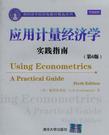应用计量经济学
2011-1
清华大学出版社
施图德蒙德
616
无
在我国高校,用英语或双语教授专业课程(以下简称:英/双语教学)始于改革开放引进热潮,历经30年,虽发展不快,仍在缓慢推进。20世纪80年代,改革开放后留学归来的教育界学者们不仅引进了各学科先进的研究成果,也随之引进了西方高校的教材。以清华大学出版社为领军的国内出版社适时地引进了西方优秀教材的影印版,推动了一些高校开始在专业课程中开展英/双语教学。2007年以来,国家教育质量工程专设的“国家高校双语教学示范课程建设点”的评定项目被视为政府教育发展的政策风向标,正有力地推动着高校英/双语教学的发展。但对英/双语教学的必要性,我国高校内部一直争议不断。争议首先围绕着中国人用英语教学的必要性。在公认英语是目前世界通用语言的前提下,英/双语教学的必要性取决于我国高校师生是否有必要及时汲取世界最新的知识和研究成果。答案是不言而喻的。况且英/双语教学省却了翻译过程,可以避免常见的信息减损和曲解问题。不过,信息发布者——教师的英语演讲能力和信息接收者——学生的英语解读能力不足又成为开展英/双语教学的障碍。因而常见的反对意见是,开展英/双语教学,课堂教学内容就会缩水,因为讲授者和听众都得花费精力和时间解译内容。如此看来,我国开展英/双语教学的高校教师必须应对挑战,洞察在我国现有条件下用英文原版教材开展英/双语教学的利和弊,并找到可行的扬长避短的路径。在经济开放和全球化的大趋势推动下,我国中小学英语教学分量加重,英语普及程度逐年提高,高校新生的英语基础愈益扎实;教师的英语能力也随着师资的新陈代谢而日见增强。这一趋势无疑在为英/双语教学营造越来越有利的条件。尽管如此,不同于以英语为主要语言或官方语言的一些国家,英语在我国的普及率仍较低。在青少年中,英语的普及程度和英语应用能力还仅处于初级水平;高校中能用英语演讲的教师尚属少数,且熟练程度还有待大幅提高。这样的师生英语基础,使得英/双语教学面临巨大的挑战。同时,在多数的中国高校课堂里,教学任务多被视为逐章讲解某本教材的内容。本土中文教材通常是400~500页的32开本,含理论框架、主要知识点、计算方法和习题,但案例和故事不在其中,多由教师在讲解时添加,以演示和诠释理论要点。迄今仍然普遍盛行的“填鸭式”、“满堂灌”的传统教学法侧重于传授知识,从多数评教指标可见,只要学生感觉教师讲得精彩、有条理、能解惑,就算教学成功。
本书结合实际案例和线性回归方程分析练习为读者解析计量经济学的实用性及应用方法。具体内容包括:计量经济学基本知识、回归分析和回归方程及其应用;普通最小二乘法对于回归模型的应用,回归方程的质量评价;回归分析应用的展开步骤及注意事项;经典模型中的假设、抽样分布、定理、属性及标准符号解析;假设检验基本情况及检验属性、示例分析和局限性;选择解释变量的设定;常数项、函数形式、滞后解释变量、虚拟变量等函数形式选择问题;多重共线性的完全性、推论、检测和补救;序列相关的纯粹性、推论、检验及补救;异方差的纯粹性、推论、检测和补救;回归应用步骤解析;时间序列模型;虚拟应变量技术;联立方程组相关问题解析;预测问题及模型;实验数据、面板数据及相关效应;统计原则问题。 本书注重实用性指导,在解析理论的同时,增强实际操作能力和网络应用,通过大量的知识、练习及案例的扩展,帮助读者更好地理解和学习相关内容。
作者:(美国)施图德蒙德(A.H.Studenmund)
序言 第1章 回归分析概述 第2章 普通最小二乘法 第3章 学会运用回归分析 第4章 经典模型 第5章 假设检验 第6章 模型设定:选择解释变量 第7章 设定:选择函数形式 第8章 多重共线性 第9章 序列相关 第10章 异方差 第11章 回归运用练习 第12章 时间序列模型 第13章 虚拟应变量技术 第14章 联立方程组 第15章 预测 第16章 实验数据和面板数据 第17章 统计原则 附录a 习题答案 附录b 统计表 索引
插图:The emphasis in this text is on estimating behavioral equations, those thatdescribe the behavior of economic entities. We focus on selecting independentvariables based on the economic theory concerning that behavior. An explanatory variable is chosen because it is a theoretical determinant of the dependentvariable; it is expected to explain at least part of the variation in the dependentvariable. Recall that regression gives evidence but does not prove economiccausality. Just as an example does not prove the rule, a regression result doesnot prove the theory.There are dangers in specifying the wrong independent variables. Our goalshould be to specify only relevant explanatory variables, those expected theoretically to assert a substantive influence on the dependent variable. Variablessuspected of having little effect should be excluded unless their possible impact on the dependent variable is of some particular (e.g, policy) interest.For example, an equation that explains the quantity demanded of a consumption good might use the price of the product and consumer income orwealth as likely variables. Theory also indicates that complementary and substitute goods are important. Therefore, you might decide to include the pricesof complements and substitutes, but which complements and substitutes? Ofcourse, selection of the closest complements and/or substitutes is appropriate, but how far should you go? The choice must be based on theoreticaljudgment, and such judgments are often quite subjective.When researchers decide, for example, that the prices of only two othergoods need to be included, they are said to impose their priors (i.e, previoustheoretical belief) or their working hypotheses on the regression equation.Imposition of such priors is a common practice that determines the numberand kind of hypotheses that the regression equation has to test. The danger isthat a prior may be wrong and could diminish the usefulness of the estimated regression equation. Each of the priors therefore should be explainedand iustified in detail.
《应用计量经济学:实践指南(第6版)》:美国商学院原版教材精选系列·清华十二五规划教材

无
对实际应用和解决实际问题非常有帮助,不是泛泛的空洞的理论